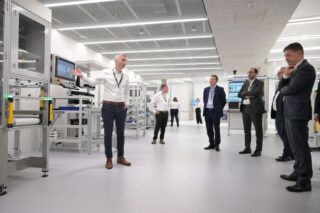AMPERE Energy is a Spain-based solar energy equipment supplier. Their range of smart batteries stores the excess energy generated by solar panels during the day to be used whenever needed. Their accompanying software is equipped with artificial intelligence, meaning their devices can self-manage supply, predict solar production, and analyze the prices in the electricity market and the user’s consumption patterns to achieve maximum savings and energy independence.
Ignacio Guerrero, AMPERE’s Chief Technical Officer, and Jose Manuel Torrelo Ponce, Head of Product & Engineering recently discussed their technology, the emerging ‘energy’ communities throughout Europe, and helping to empower rural communities.

How did the company start?
Jose Manuel Torrelo Ponce
“AMPERE was created in late 2015 and started operating as a company in early 2016. The first shareholders of this company had a clear vision of how energy should be managed around the world; it needed to be stored, as well as managed. They set up the company with a few engineers and started to develop the first product that we released to the public, Square.
Since the beginning, we believed that we needed to get more benefits from photovoltaic installations, because there was a lot of surplus that couldn’t be stored, and sometimes you cannot export to the grid without any kind of control.
During our first year, we focused on managing that energy surplus using the energy storage in the batteries and then using that energy in an intelligent way later, when the energy is needed.
In the beginning, we knew that we had to work efficiently to manage these energies; for example, we had to consider weather forecasts and energy prices at different hours and predict consumption for the next day. So all these data systems were able to adapt how they managed energy from day to day. At first, it was very focused on single residential buildings, but over the years we have constructed a range of products; now Square is the smallest one.”

Ignacio Guerrero
“When we started the company, we realized that there were very few in the industry introducing batteries alongside photovoltaic installations. Managing energy at that point was not what we now define as ‘smart.’ Batteries back then acquired an energy surplus from photovoltaics and then discharged it from the battery as soon as there was a demand.
But that isn’t optimal in some electric markets, especially in Spain. The Spanish electric market is one of the most complex markets in Europe, if not the world; we have a lot of price signals in both energy and power.
Part of the reason is that apart from Portugal, we cannot easily work with other countries to provide or accept energy. Spain is a peninsula, but in terms of energy, it works more like an island.
Even in little residential areas using only up to three kilowatts of power, people need to subscribe for power; going over that power means they can get either economic penalties or even a blackout.
That amount of power of subscriber power can change over the day. You can subscribe to some power from midnight to 8 am, and then switch to lower-cost battery power from 8 am to the rest of the day. It’s a way to both help people save money and to make it easier to manage the whole grid.
That said, controlling battery power is rarely easy for customers, which is our priority. We started focusing a lot on the AI ‘brain’ of the battery, developing machine learning algorithms that let the device know how much the photovoltaic panels will generate, where it is generated, and how much energy will be consumed. We will then compare this information to the energy tariffs to find the battery’s ideal behavior for that day. That will maximize the battery’s economic potential.”




Working with Spain’s fractured energy infrastructure means you started on ‘Hard Mode’?
Jose Manuel Torrelo Ponce
“We started the hard way with our smallest system, a three-to-six kilowatt-hour model called Square Pro. But we have been expanding our range of products. We now cover bigger residential buildings, small commercial buildings, industry, and also ‘energy communities.’ We also provide systems to support quick charging stations, which allows us to provide up to 360 kilowatt hours. This lineup of products has been also done with an evolution of our software for both individual monitoring stations and managing fleets of systems.
We have two kinds of solutions; one is more oriented to giving services to customers – the owners of the installation, which can stretch from an individual household to energy communities.
The other solution is a layer of software that manages the systems that together give services to the grid. The software has been developed in parallel with our other developments to integrate any type of device, allowing it to manage several devices.”

What challenges did you face adapting the software to these different settings?
Ignacio Guerrero
“We knew when we decided to scale up that we needed to have a reliable communications channel between the individual systems and the central ‘brain’ in the cloud. This would allow us to develop and implement the algorithms and technology needed both in the systems and in the cloud.
We came from a very complex and heavily used technology in residential buildings. Every one of those batteries has its daily program depending on the energy demand, photovoltaic focus, and time rates.
Each day the batteries create that ‘ideal program’ by themselves. The higher layers that work en masse to organize – for example, energy communities – need to communicate with each battery to learn of their unique ideal hourly rates. In the end, this allows us to combine all of these layers for different uses.
For example, in a typical energy community, you could have generators, the ‘prosumers’ generating more energy than they consume, and regular consumers. We provide a device in their building to measure their real-time consumption. This is then sent to our cloud system, which combines all the individual members’ consumption into a wider community consumption. This is then relayed back to the battery every five seconds. And then the battery learns from the total community’s consumption and photovoltaic production in a community-wide plant scheme.
The idea with all these connections is to monitor the intra-day energy prices on the spot market, to check whether it is more cost-effective to provide services to the grid from our community or to use the energy generated within the community to save money.
We’re also thinking beyond this; on top of energy communities, we have developed this idea of a ‘virtual power plant’ that goes beyond providing services to members of one energy community to providing services to the wider grid.”

Digitizing how people use and store the energy was a priority for you. How does this work in practice?
Ignacio Guerrero
“Since the device itself doesn’t have a human-machine interface, we designed the MyAmpere app to help the user interact with the device. The app is already able to provide insights into the consumption of the user and the generation that has been generated from the PV panels, but it is also able to provide you information about the appliances that you’re using every day, such as washing machines, cookers, water boilers, and so on.
This is all without the need to install ‘smart plugs’ on the devices. We use a technology called non-intrusive load monitoring, which means that just with algorithms we’re able to disaggregate the appliances from the general measurement of the consumption of the user.
For example, the app can recommend that instead of using the dishwasher at 11 pm, you could use it at 11 am using a surplus of solar power, which will save you money.
We can also easily see if any of their devices are inefficient. For example, if a fridge is very old, we can recommend that the user buy a new fridge because the energy savings from the new fridge will pay for the new fridge in perhaps three months.
One thing that we have included recently is our ‘energy community vision.’ This allows a community manager to use the app to check all the consumption and generation points from a single energy community and check all the stats at the plant and individual levels. The members of that energy community are also able to see the overall thoughts and behavior of the energy community and their consumption – but they cannot see others’ consumption.“


You are also researching how to strengthen energy communities.
Jose Manuel Torrelo Ponce
“With the EU-funded ebalanceplus project, we are mainly working with two pilots. One is in the University of Málaga, where we have installed two systems and we will likely install one more by the summer. They are centralized energy storage systems for 120kWh.
The two systems that they have right now were recently installed and they are starting to work with them, and a third one is to be installed this year.
These systems are also using the ebalanceplus platform to be managed externally using an API using the central manager that is being developed during the project.
In this case, the main intelligence of the system relies on the ebalanceplus platform to develop a schedule of what the system has to do rather than charging or discharging at different hours
Something similar is going to be done at the University of Calabria with smaller systems. In this case, we are talking about the 3 to 6 kWh Squares, which are our smallest product, and the 36kWh T-Pros which are for residential or small commercial systems.
The project is installing the Square Pros in student apartments and the 12-36kWh T-Pros are being installed in some laboratories of the university. Here we are a provider of technology; what we have done is develop those solutions and provide an interface through an API to have control of the ebalanceplus platform.
We have just finished commissioning the first two systems in Malaga. We were slowed slightly due to getting all the permissions, so we are only expecting the first round of feedback in the next few months. Afterward, we will be able to update that feedback with the feedback from the ebalanceplus consortium.
We need to be able to check how the systems are working in those conditions. Within ebalanceplus we have some targets to achieve; for example, we want the cost of energy storage in the buffer to be below a certain number, and fortunately we got it below that during the project. These kinds of products are like financial products; it only makes sense if the price makes sense.”


What lessons did you learn from working in rural versus urban settings?
Ignacio Guerrero
“In the past, our main focus was the Spanish market, but as soon as we could we started selling devices abroad. We have sold quite a lot of devices in Portugal, Italy, Ireland, the UK, Belgium, and on the other side of the ocean in Chile and Colombia.
It’s true that when it comes to energy communities things have been different. The performance and the way they work changes quite a lot even from cities to rural areas in the same country.
For example, when it comes to some countries in Eastern Europe, you find that communities have already installed PV panels and batteries, they have done a lot in the spirit of the right direction. So the way the energy community is formed is completely different.
In energy communities we often talk about the ‘sharing coefficient’ – the proportion of energy that should be shared with each member of that community. This can be done dynamically, though if one is starting an energy community from nothing, often the community is entirely made of consumers who then invest in a central PV installation. Then the sharing coefficient depends on the investment of every single member. Some members could invest 10% of the installation and some others can only invest up to 5%.
So in these communities, the sharing is done mainly by the initial investment. If you go to Germany, for example, or to eastern countries in Europe you find that when the energy community arrives, many people have already installed solar panels.
So in that regard, the sharing sometimes has more to do with the power demand and the consumption, or even the duration from each one of those households. Oftentimes a country or municipality’s regulations have a lot to do with the economic feasibility of energy communities.
So for the moment, we have decided to focus on the Spanish market, so we’re not working abroad when it comes to energy communities and we’re working mostly in rural areas. It makes more sense for us to work there because, in Spain, the biggest proportion of the population is concentrated in four or five cities.
In these cities, there are a lot of tall buildings with very little surface area for PV panels but with a lot of consumption. So in those buildings, the energy communities do not work very well, because even though you cover all the roofs with panels, you are not going to be able to reach a solar coverage of more than 15-20% of the consumption.
It makes more sense to work in the rural areas. The mayors of these rural areas of those towns are losing their population every single year and one way that they can maintain the population and encourage more people to move to there is energy. There is a very powerful argument blossoming here in Spain; what if towns generate their energy and share it with the local population? That argument is super powerful, and we’re working in those types of communities.
Normally the mayors in these types of communities do it for politics; it’s good for them in the end because they want to get and keep votes, but in the end, this is something that is started by the mayor but paid for by a state financial device, so that the people doesn’t need to invest anything upfront.
In the end, they achieve big savings on their monthly bills, but they also achieve competitive energy power. Industries that want to expand in these towns may not be able to do so because it would create too high an energy demand in the town, so the company moves elsewhere. Now with the energy community, they could use both the very cheap energy generated through renewables and stored through batteries to stay in these towns.”

What reasons do you see for the recent interest in AMPERE?
Ignacio Guerrero
“We know that batteries are going to be used more in our society in the years to come. The vision from the founders in the beginning was that batteries were going to turn into a commodity. And we’re probably very close to that.
Climate change and conflicts are making people think even more about energy consumption, where they get their energy, and the security of this energy. For example, during COVID we had many discussions with clients that they were feeling more safe than before because during the COVID crisis, we didn’t know if we were going to run out of energy. There was no guarantee that you have that you’re going to be able to turn on the lights.
The next thing is timing. In Spain, we came from the moment in which all the energy retailers were providing variable tariff rates; depending on the hour, you get different tariff rates. Now after COVID and the invasion of Ukraine, people say they don’t care if they have to pay more, they just want a fixed price to avoid the stress of not knowing whether they can pay their next energy bill. So people are acting differently, and the idea of using batteries alongside solar installations is now much more attractive for people investing in the future.
Now we see that energy companies are starting to offer batteries. It’s been quite a big change in the Spanish market. A couple of years ago, many electrical companies were only talking about photovoltaic installations for residential use, though they are now expanding to industry.
Timing means that we were able to learn lessons from more mature markets like those in California and Australia. We know now that you cannot store the entire energy in the grid today to be then used for tomorrow. You need to produce at the moment that you’re going to use it, and the best way to do that is in batteries. Apart from recommending batteries, we have also started to do more work to encourage energy communities. We know we are right on the path, and this is because of the technology and potential we are providing ourselves.”











